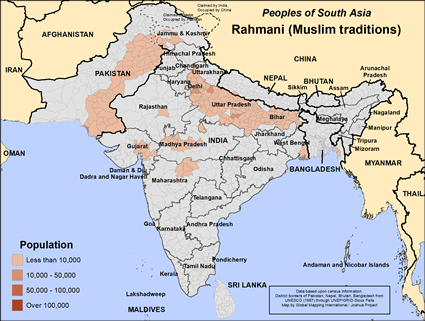Rahmani (Muslim traditions) in India

Photo Source:
Anonymous
|

Map Source:
People Group data: Omid. Map geography: UNESCO / GMI. Map Design: Joshua Project.
|
| People Name: | Rahmani (Muslim traditions) |
| Country: | India |
| 10/40 Window: | Yes |
| Population: | 237,000 |
| World Population: | 301,000 |
| Primary Language: | Hindi |
| Primary Religion: | Islam |
| Christian Adherents: | 0.00 % |
| Evangelicals: | 0.00 % |
| Scripture: | Complete Bible |
| Ministry Resources: | Yes |
| Jesus Film: | Yes |
| Audio Recordings: | Yes |
| People Cluster: | South Asia Muslim - other |
| Affinity Bloc: | South Asian Peoples |
| Progress Level: |
|
Introduction / History
The Rai Bhat people live in Uttar Pradesh. They speak Urdu and Hindi and read and write in Perso-Arabic and Devanagari. Bhat were traditionally court performers. The Bhat recited poetry, often in a very high, sing-song voice.
What Are Their Lives Like?
Today, they continue the practice of phakras which is a poetic speech used to praise others. But most work in cultivation. They are not well educated so the gospel will need to be given in oral form. The Rai Bhat people usually marry their cousins. Monogamy is their usual way. They allow for divorceand remarriage. On the death of the father, the children inherit the property with sons getting morethan the daughters.
What Are Their Beliefs?
Despite being a very creative people group, the Bhat have tended to adopt the religion of those they have served. For some that means following Islam. For others, it involves following Hinduism. Ancestor worship and the occult also continue to be practiced among the Bhat. Like most Muslim communities they bury their dead.
What Are Their Needs?
The Rai Bhat people need to experience the life changing transformation that only Jesus Christ can offer.
Prayer Points
Pray that as the Rai Bhat read about Jesus in the Koran, they will read the Bible and come to Jesus Christ. Pray for spiritual discernment and hunger that will lead them to the only Savior, Jesus Christ. Pray for a powerful move of the Holy Spirit that will lead to a church planting movement.